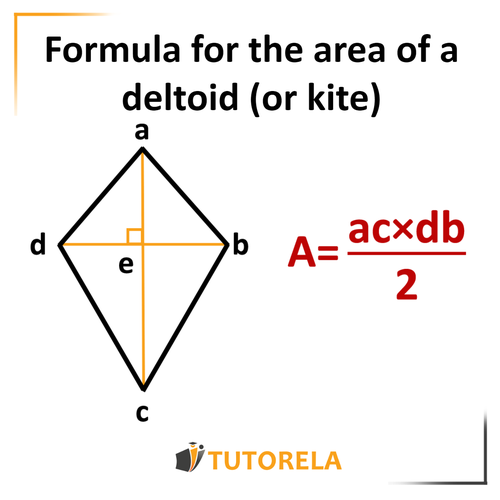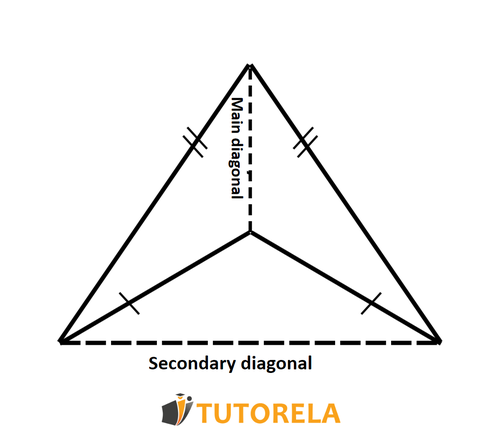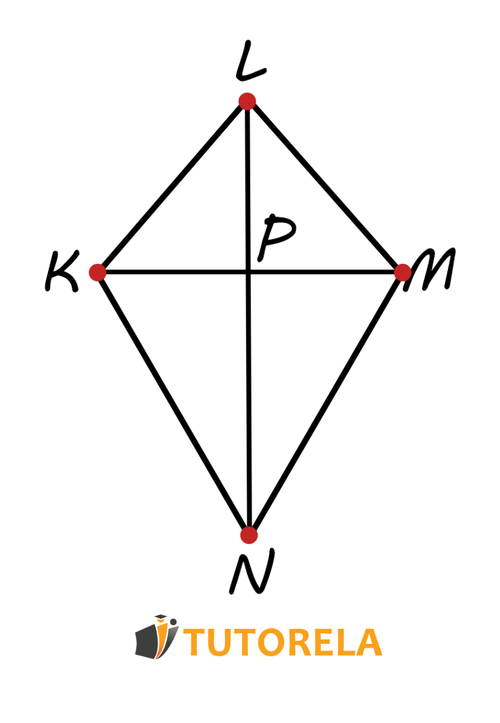The area of the kite can be calculated by multiplying the lengths of the diagonals and dividing this product by .
Area of a Deltoid (Kite)
How do we calculate the area of a kite?
Deltoid Area Formula
To facilitate the understanding of the concept of calculus, you can use the following drawing and the accompanying formula:

Test yourself on area of a deltoid!
Look at the deltoid in the figure:
What is its area?
There are many geometric shapes that can be found during the solving of engineering problems at all different stages of study, such as in high school, in matriculation exams, and even in psychometry. One of the less trivial shapes is the deltoid and, as part of the questions surrounding it, students are often asked to calculate the area of the deltoid.
What is the deltoid?
A deltoid is a polygon with four sides (that is, a quadrilateral) with two distinct sets of adjacent sides of equal length to each other.
Look at the deltoid in the figure:
What is its area?
ACBD is a deltoid.
AD = AB
CA = CB
Given in cm:
AB = 6
CD = 10
Calculate the area of the deltoid.
ABDC is a deltoid.
AB = BD
DC = CA
AD = 12 cm
CB = 16 cm
Calculate the area of the deltoid.
Types of Deltoids
There is a clear distinction between convex deltoid and concave deltoid.
Convex deltoid
Convex deltoid is a deltoid where the diagonals are inside and cross each other. The longer diagonal acts as a main diagonal, while the shorter diagonal acts as a secondary diagonal.
As you can observe in the following drawing, the main diagonal divides the deltoid into two overlapping triangles, that is, identical, and the secondary diagonal divides the deltoid into two isosceles triangles whose bases are adjacent and, indeed, identical.

Shown below is the deltoid ABCD.
The diagonal AC is 8 cm long.
The area of the deltoid is 32 cm².
Calculate the diagonal DB.
Look at the kite ABCD below.
Diagonal DB = 10
CB = 4
Is it possible to calculate the area of the kite? If so, what is it?
Given the deltoid ABCD
Find the area
Concave Kite
Concave kite is a kite where one of the diagonals (main diagonal) passes inside the kite and the other diagonal (secondary diagonal) passes outside the kite.
The concave deltoid can be described as a shape consisting of two isosceles triangles that share a common base, where one triangle contains the other triangle. The following drawing better describes the concave deltoid:

- When all sides of the kite have the same length, a rhombus is obtained, which is actually a special case of a kite.
- Another special case of a kite is a square, when it is a case where all sides and all angles are of the same size.
Properties of the Kite
- The angles on the sides, or more precisely, the angles between the different adjacent sides of the kite, are of equal size.
- The diagonals of the kite are perpendicular to each other
- The main diagonal in the convex kite (or its extension in the concave kite) crosses the secondary diagonal (in both cases), and therefore actually functions as a perpendicular bisector
- The main diagonal equally divides (crosses) the main angles of the kite
- Every convex kite has the possibility of enclosing a circle
- In every kite, there are two sets of adjacent sides of equal size
- As mentioned, a concave kite is characterized by a secondary diagonal located outside of it
Given the deltoid ABCD
Find the area
Given the deltoid ABCD
Find the area
Given the deltoid ABCD
Find the area
Practice on the Area of a Kite
Exercise 1
Given the kite whose area is cm², the meeting point of the diagonals and .
The area of the section KP must be calculated according to the attached drawing and the existing data:
- cm
- cm²

Solution:
This exercise is a reverse calculation, that is, we know the area and we are asked to calculate the length of the segment .
In the first step, we replace the data we know in the kite area formula.
We obtain:
We simplify the expression and obtain:
In fact, we found the length of the second diagonal of the kite.
According to one of the properties of the kite, the diagonal divides the diagonal into two equal parts.
From here we obtain that is equal to cm.
Answer:
cm
Examples and exercises with solutions for the Area of the Kite
Exercise #1
Look at the deltoid in the figure:
What is its area?
Video Solution
Step-by-Step Solution
Let's begin by reminding ourselves of the formula for the area of a kite
Both these values are given to us in the figure thus we can insert them directly into the formula:
(4*7)/2
28/2
14
Answer
14
Exercise #2
Look at the deltoid in the figure:
What is its area?
Video Solution
Step-by-Step Solution
To solve the exercise, we first need to know the formula for calculating the area of a kite:

It's also important to know that a concave kite, like the one in the question, has one of its diagonals outside the shape, but it's still its diagonal.
Let's now substitute the data from the question into the formula:
(6*5)/2=
30/2=
15
Answer
15
Exercise #3
ACBD is a deltoid.
AD = AB
CA = CB
Given in cm:
AB = 6
CD = 10
Calculate the area of the deltoid.
Video Solution
Step-by-Step Solution
To solve the exercise, we first need to remember how to calculate the area of a rhombus:
(diagonal * diagonal) divided by 2
Let's plug in the data we have from the question
10*6=60
60/2=30
And that's the solution!
Answer
30
Exercise #4
ABDC is a deltoid.
AB = BD
DC = CA
AD = 12 cm
CB = 16 cm
Calculate the area of the deltoid.
Video Solution
Step-by-Step Solution
First, let's recall the formula for the area of a rhombus:
(Diagonal 1 * Diagonal 2) divided by 2
Now we will substitute the known data into the formula, giving us the answer:
(12*16)/2
192/2=
96
Answer
96 cm²
Exercise #5
Shown below is the deltoid ABCD.
The diagonal AC is 8 cm long.
The area of the deltoid is 32 cm².
Calculate the diagonal DB.
Video Solution
Step-by-Step Solution
First, we recall the formula for the area of a kite: multiply the lengths of the diagonals by each other and divide the product by 2.
We substitute the known data into the formula:
We reduce the 8 and the 2:
Divide by 4
Answer
8 cm
Given the deltoid ABCD
Find the area
Given the deltoid ABCD
Find the area
Given the deltoid ABCD
Find the area
More Questions
Area of a Deltoid
- Calculate Triangle Ratios in a Deltoid: Using the 1:5 Point Relationship
- Deltoid Geometry: Calculate the 1:3 Point Division and Triangle Area Ratio
- Deltoid Area Calculation: Using 4cm and 5cm Diagonals
- Deltoid Diagonal Calculation: Finding AC When Area = 24cm² and DB = 4
- Calculate the Second Diagonal in a Deltoid with Area 18 cm² and First Diagonal 3 cm
- Area
- Trapezoids
- Area of a trapezoid
- Perimeter of a trapezoid
- Parallelogram
- The area of a parallelogram: what is it and how is it calculated?
- Perimeter of a Parallelogram
- Kite
- Rectangle
- Calculating the Area of a Rectangle
- The perimeter of the rectangle
- Congruent Rectangles
- The sides or edges of a triangle
- Triangle Height
- The Sum of the Interior Angles of a Triangle
- Exterior angles of a triangle
- Rhombus, kite, or diamond?
- The Area of a Rhombus
- Perimeter
- Triangle
- Types of Triangles
- Obtuse Triangle
- Equilateral triangle
- Identification of an Isosceles Triangle
- Scalene triangle
- Acute triangle
- Isosceles triangle
- The Area of a Triangle
- Area of a right triangle
- Area of Isosceles Triangles
- Area of a Scalene Triangle
- Area of Equilateral Triangles
- Perimeter of a triangle
- Areas of Polygons for 7th Grade
- Right Triangle
- Area of a right-angled trapezoid
- Area of an isosceles trapezoid
- Median in a triangle
- Center of a Triangle - The Centroid - The Intersection Point of Medians
- How do we calculate the area of complex shapes?
- How to calculate the area of a triangle using trigonometry?
- How do we calculate the perimeter of polygons?
- All terms in triangle calculation
- Symmetry in a kite









